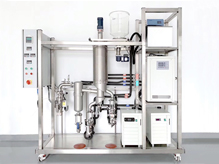Outstanding features of molecular distillation
Molecular distillation is mainly used in the process of high molecular weight, temperature resistance and high boiling point distillation. In the process of production, it is mainly composed of an externally heated vertical cylinder, which is located at its center during operation. And a wiper that rotates between the distiller and the condenser. The material is added from the top of the evaporator, and is continuously and evenly distributed on the heating surface through the liquid distributor on the rotor, and then the wiper scrapes the liquid into a very thin, turbulent liquid film and spirals. Push down. To a certain extent, the light molecules that will escape from the heating surface will be condensed into a liquid on the built-in condenser after a short route and hardly collided, and flow down the condenser tube through the evaporator. The discharge pipe at the bottom is discharged; the residual liquid, that is, the heavy molecules, is collected in a circular passage under the heating zone, and then flows out through the discharge pipe on the side.
Compared with conventional distillation, molecular distillation has the following incomparable characteristics:
(1) Low operating temperature, which can greatly save energy. Conventional distillation relies on the difference in boiling point of different substances in the material mixture. Molecular distillation is separated by the difference in the mean free path of molecular motion of different substances. It is required that the material must reach a boiling state, and separation can be achieved as long as the molecules are volatilized from the liquid phase. Because molecular distillation operates at a distance from the boiling point, the energy consumption of the product is small.
(2) The distillation pressure is low, and it is required to operate under high vacuum. The mean free path of molecular motion is inversely proportional to the system pressure. Only by increasing the vacuum can a large enough mean free path be obtained. Studies have shown that the degree of vacuum in molecular distillation is as high as 0.1-100 Pa.
(3) Short heating time reduces thermal damage of heat sensitive substances. Since molecular distillation is achieved by utilizing the difference in the mean free path of molecular motion of different substances, the basic requirement is that the distance between the heating surface and the condensation surface must be smaller than the moving mean free path of the light molecule. This distance is usually small, so the light molecule is After the liquid surface escapes, there is almost no collision, that is, it is directed to the condensation surface, so the heating time is extremely short.

- High-tech Zone, Zhengzhou City, Henan Province, China.
- +86 132 9817 7608
- info@rotovap-wellknown.com
- li249869402
Copyright © Zhengzhou Well-known Instrument & Equipment Co.,Ltd. All Rights Reserved Sitemap










